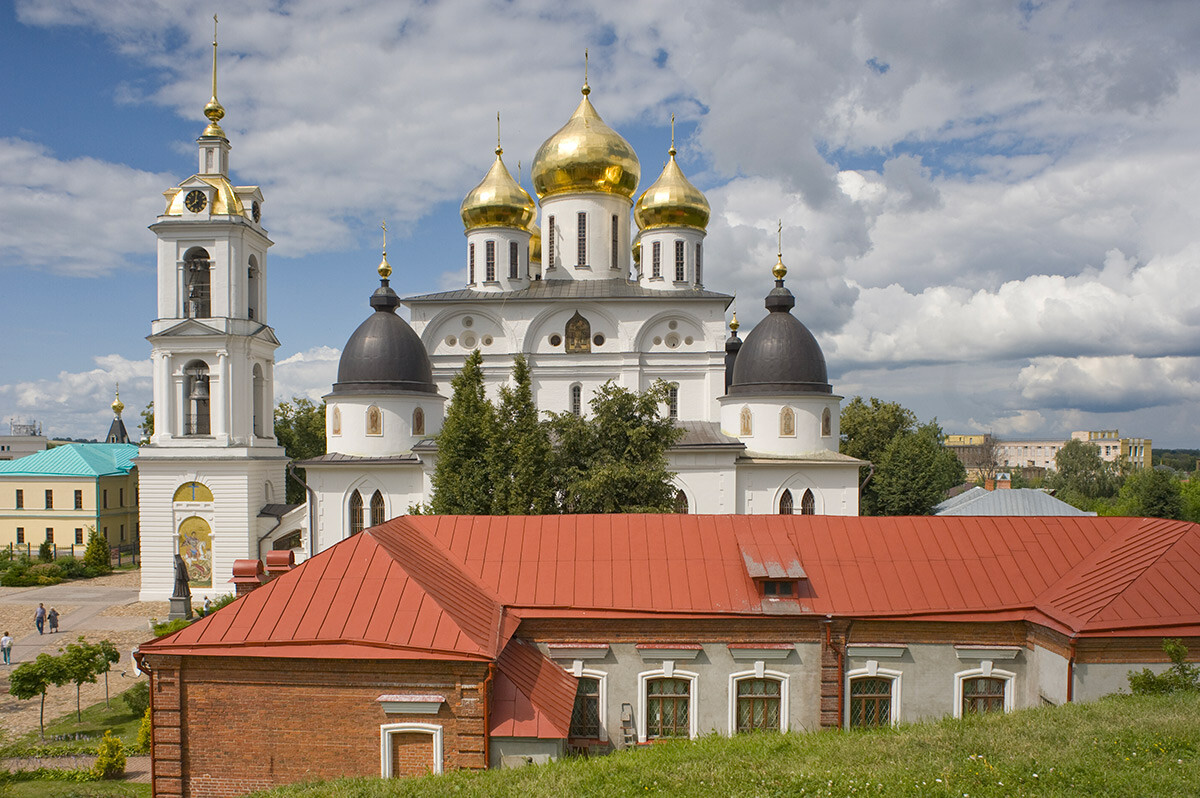
Dmitrov. Dormition Cathedral with bell tower, south view from citadel rampart. Foreground: Parish House. July 18, 2015
William BrumfieldAt the beginning of the 20th century, Russian chemist and photographer Sergey Prokudin-Gorsky developed a complex process for vivid, detailed color photography (see box text below). His vision of photography as a form of education and enlightenment was demonstrated with special clarity through his photographs of architectural monuments throughout the Russian heartland.
An excellent example is the small town of Mozhaisk, which Prokudin-Gorsky visited in the Summer of 1911 as part of a project to document sites connected with the centennial of the Napoleonic invasion of Russia. He was particularly taken by the festively decorated St. Nicholas Cathedral, located at the town’s highest point.
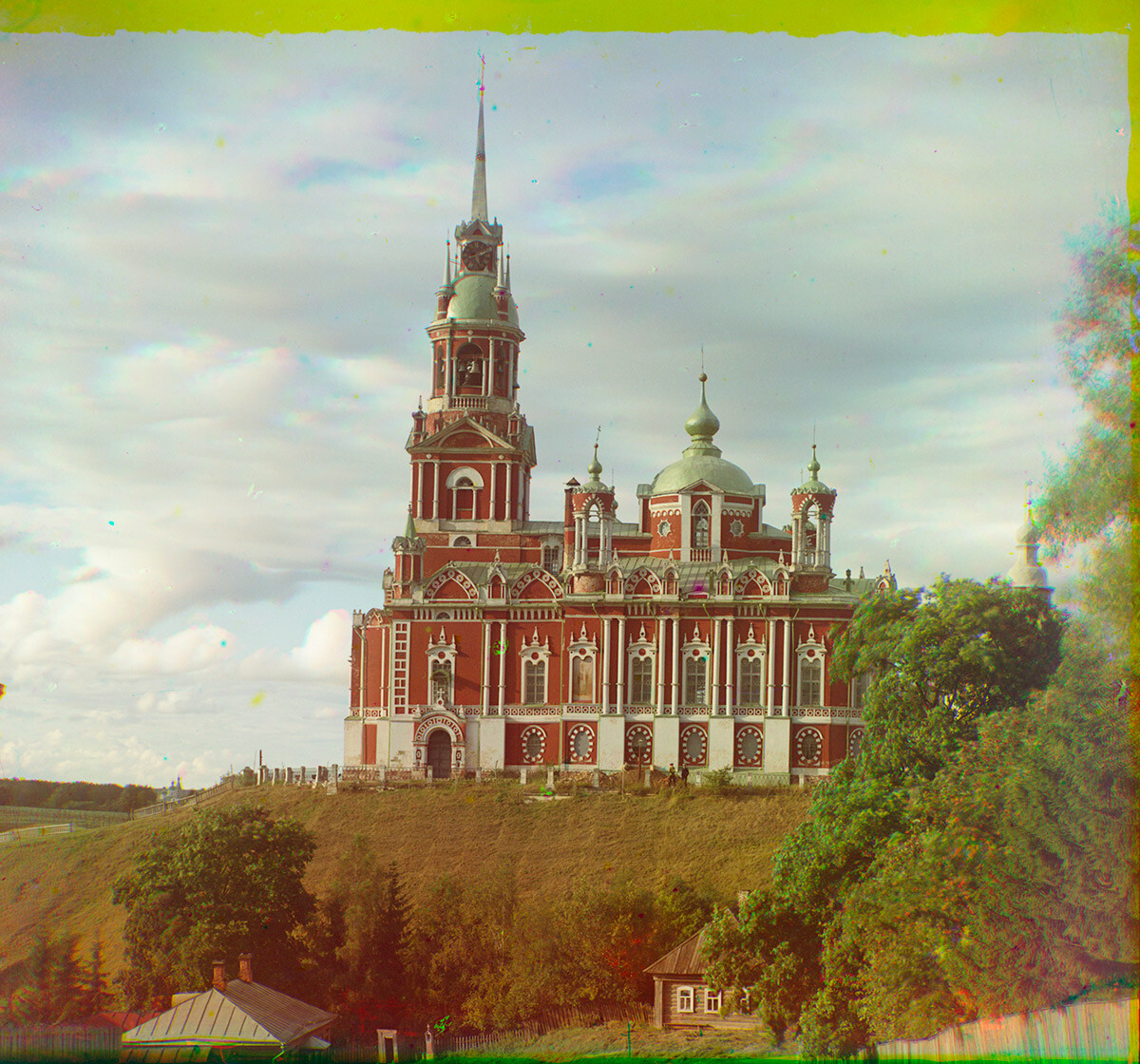
Mozhaisk kremlin (citadel). Cathedral of St. Nicholas, north view. Summer 1912
Sergey Prokudin-GorskyMoscow Region has several historic towns that have preserved significant parts of their medieval heritage. One of the most appealing is Dmitrov, located 65 kilometers north of Moscow.
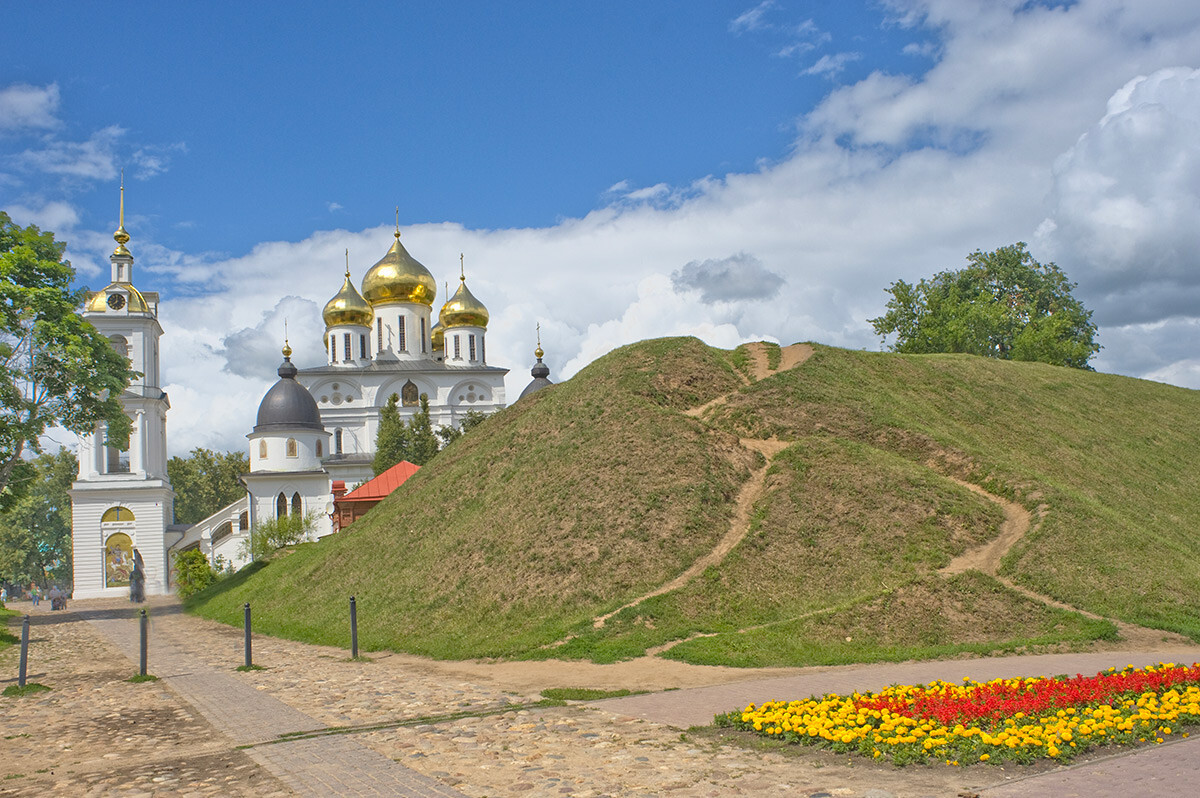
Dmitrov. Dormition Cathedral & bell tower, south view. Foreground: medieval citadel rampart. July 18, 2015
William BrumfieldArcheological excavations near the town citadel indicate the existence of a settlement in prehistoric times. The still-preserved massive earthen walls, dating from the 12th century, originally supported a wooden fortress with several towers and two main gates.
Officially, Dmitrov was founded in 1154 by Prince Yury Dolgoruky, also known as the founder of Moscow (in 1147). He named the town in gratitude for the birth of a son, Vsevolod, whose baptismal name was Dmitry in homage to Demetrios of Thessaloniki, a saint greatly revered in medieval Rus’.
Located to the north of Moscow on the Yakhroma River, Dmitrov was favorably situated with access to the vast Volga River basin by way of the Sestra and Dubna Rivers. Over land, Dmitrov lay on a main route to the northern forests, but it also had links south and east to the major Vladimir principality, for which it served as a fortified border post.
During the first two centuries of its existence, Dmitrov experienced constantly changing boundaries of feudal principalities and allegiances. The settlement recovered from the Mongol invasion that devastated Vladimir and Moscow in the Winter of 1237-1238, but it was sacked again in 1294 as part of a punitive campaign against the northeastern Russian lands by Tudan, brother of the khan of the Mongol Golden Horde. This vastly destructive invasion was facilitated by warring Russian princes.
During the late 13th and early 14th centuries Dmitrov briefly became the center of its own principality, but it remained within Moscow’s orbit and, in 1364, was formally annexed by its powerful neighbor. The town was devastated again, in 1382, by Khan Tokhtamysh in retaliation for the victory of Moscow’s grand prince Dmitry Donskoy over a major Tatar-Mongol army in 1380.
The final sack of Dmitrov by Tatar-Mongol forces occurred as part of a major raid launched in 1408 by Edigu, who routed Tokhtamysh in 1406 and subsequently founded the Nogai dynasty. The fragmentation of the Golden Horde at this time gave Moscow new possibilities, but also increased the destructive chaos for Russia in the early 15th century.
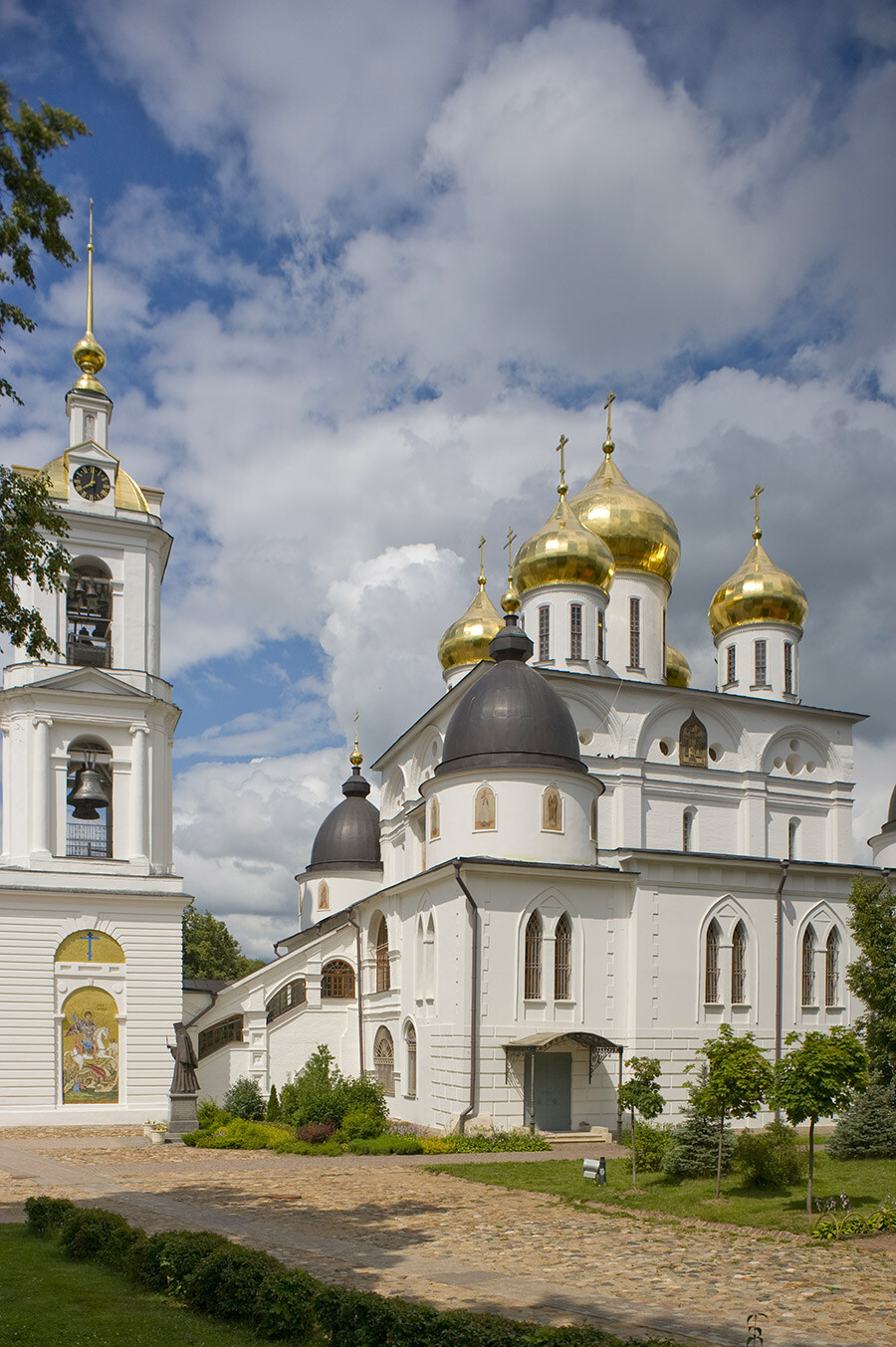
Dormition Cathedral & bell tower, southwest view. Foreground: attached Chapel of St. Sergius Rodonezh. July 18, 2015
William BrumfieldDmitrov achieved the height of its commercial power during the 16th century, beginning with the rule (1505-1534) of Prince Yury Ivanovich, the second son of Moscow’s Grand Prince Ivan III (the Great). During this period the town assumed a pivotal role in a north-south trading axis that extended south toward the Caspian. Dmitrov merchants supplied northern towns with grain from the south and in turn provided Moscow with valuable fur pelts and salt from the north.
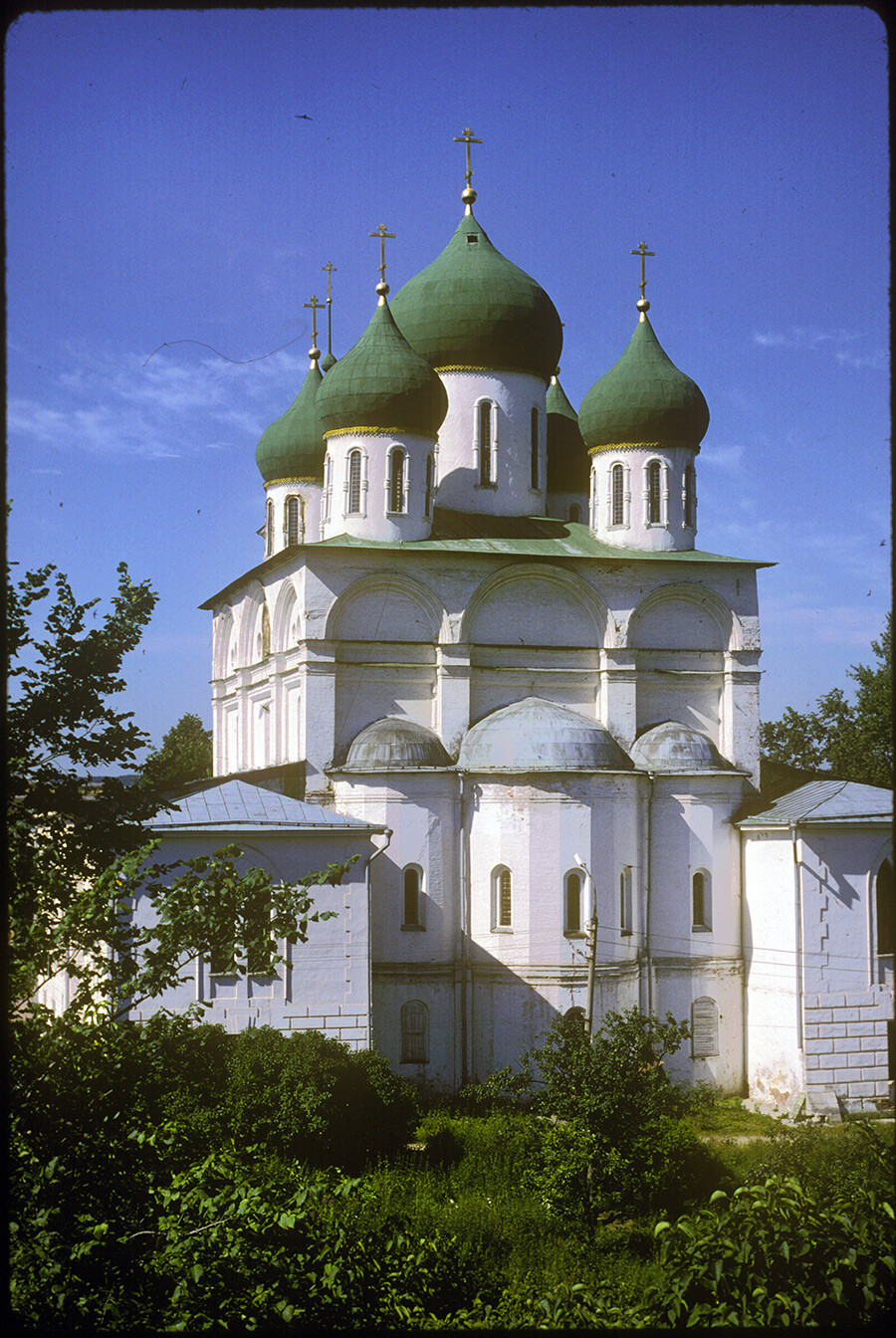
Dormition Cathedral. East view toward apse. July 20, 1997
William BrumfieldPrince Yury supported the construction within the town citadel of a large masonry cathedral dedicated to the Dormition of the Virgin Mary. Begun in 1509, the brick Dormition Cathedral rested on a limestone base with monumental, whitewashed walls in a style similar to the Archangel Cathedral in the Moscow Kremlin. The structure was crowned with five cupolas. Of special note is 16th-century ceramic relief of the Crucifixion in the middle gable of the south facade.
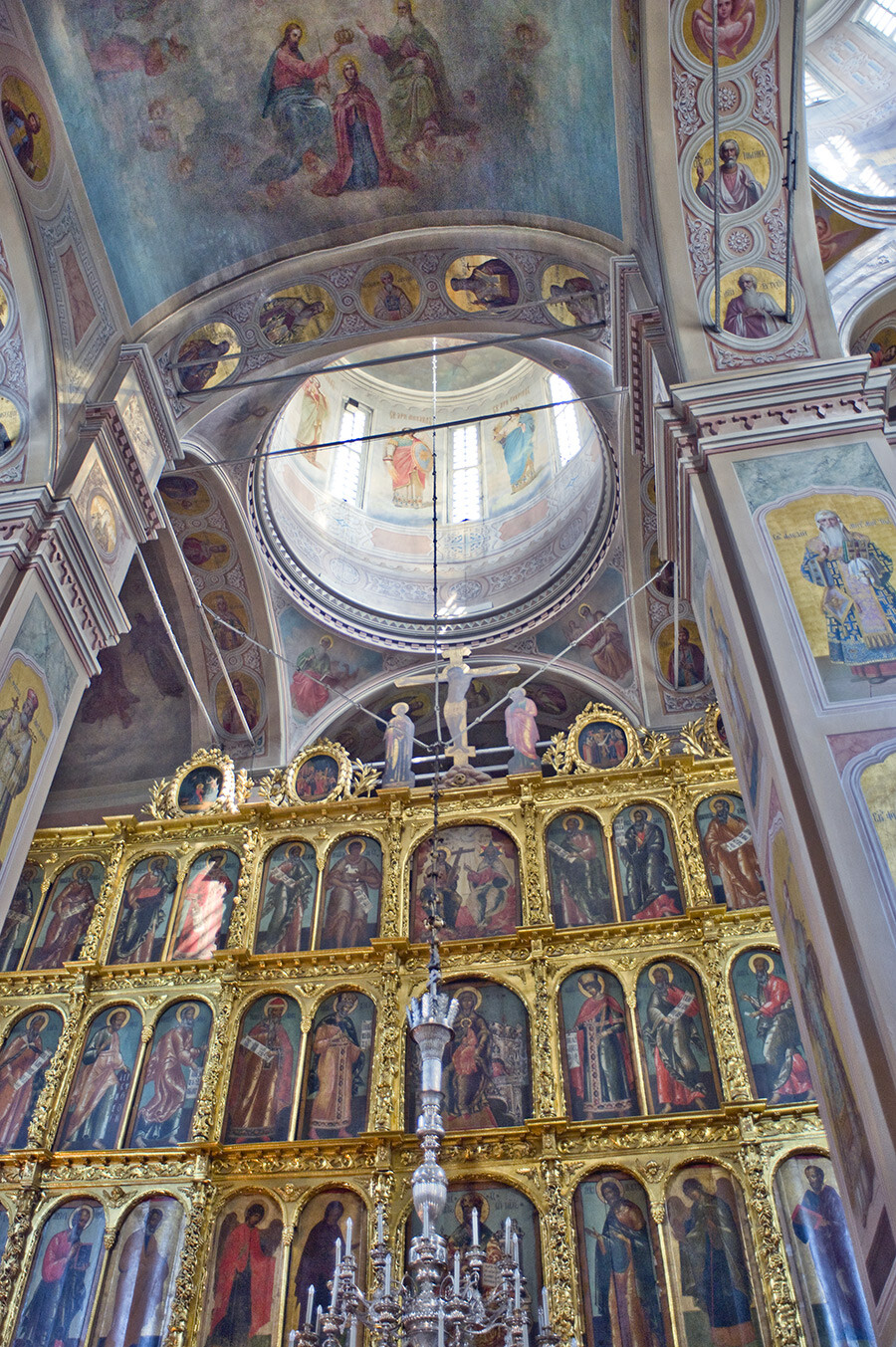
Dormition Cathedral, interior. East view toward icon screen & central dome. 19th-century fresco of Coronation of the Virgin. July 18, 2015
William BrumfieldCompleted in 1533, the Dormition Cathedral was frequently modified, Its curved gable roof was straightened, and side chapels and a narthex were added in the 18th and 19th centuries. The cathedral interior, with four massive piers, has been renovated and now includes a magnificent icon screen.
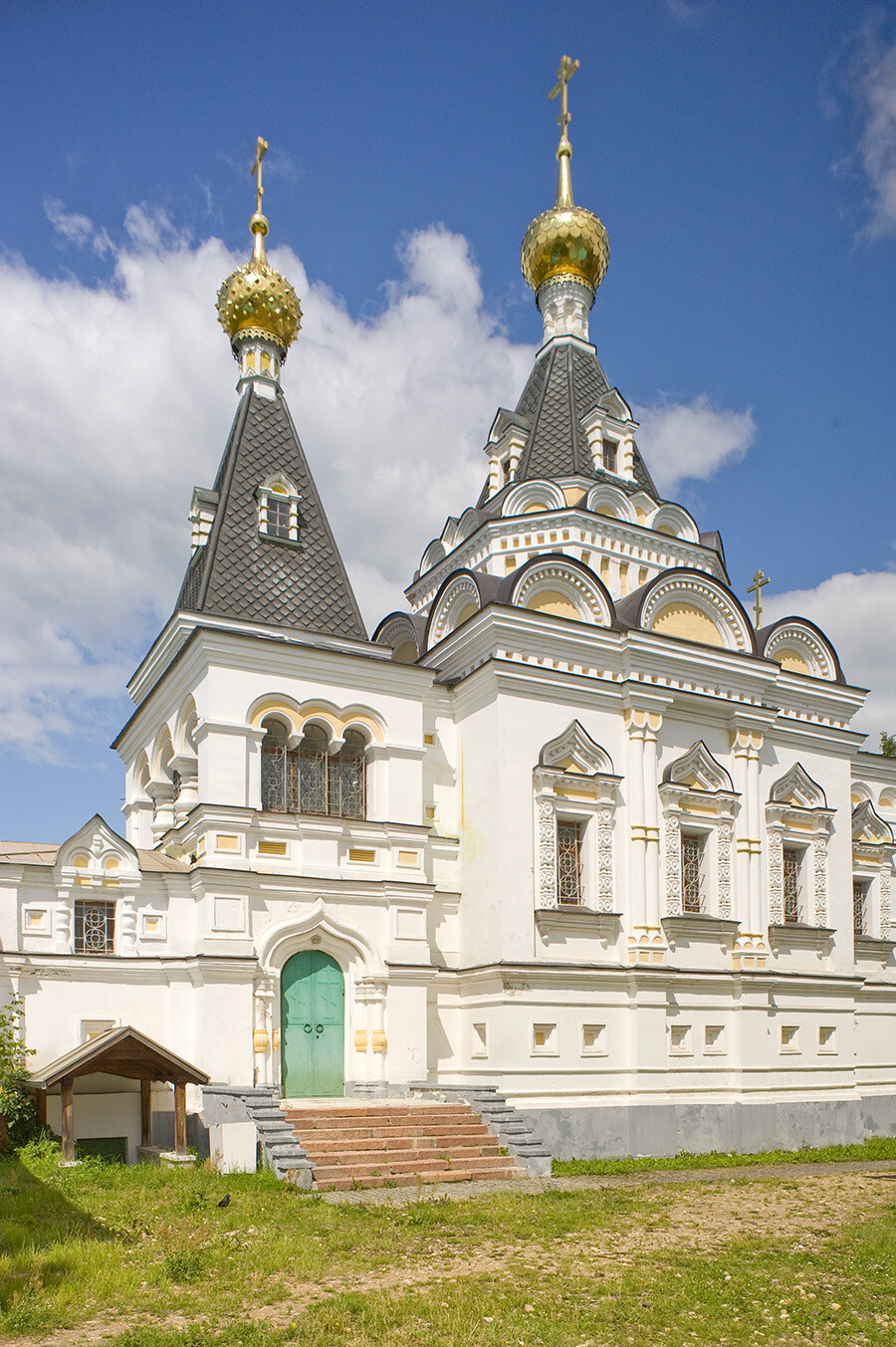
Church of St. Elizabeth, southwest view. Fine example of Pseudo-Russian" style, built in 1897-98 by Sergey Rodionov. Now used as baptismal church for Dormition Cathedral. July 18, 2015
William BrumfieldAlso completed in the 1530s was an imposing brick church in the Monastery of Sts. Boris and Gleb, first referred to in 1462. Although it has only one cupola, the Cathedral of Sts. Boris and Gleb is similar in design to the nearby Dormition Cathedral.
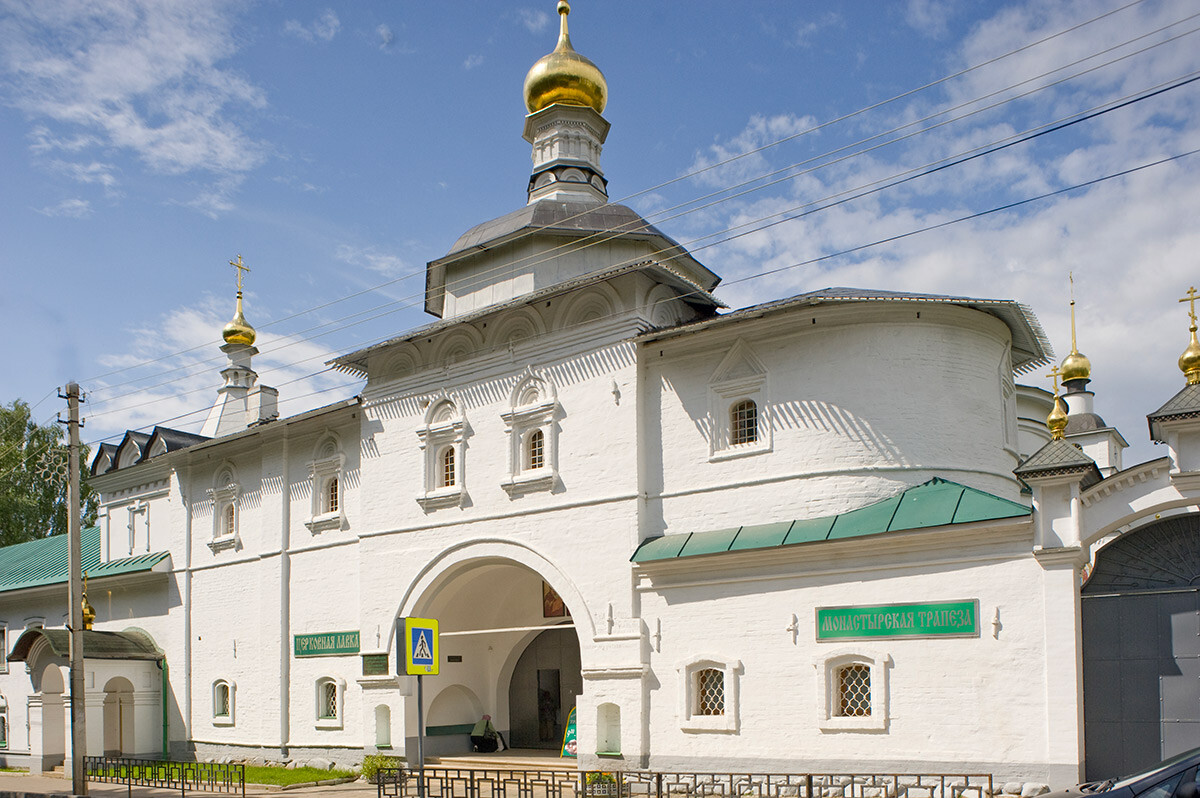
Monastery of Sts. Boris & Gleb, Church of St. Nicholas (1685-7) over Holy Gate (1672), southeast view with green ceramic strip. July 18, 2015
William BrumfieldFortunately, the monastery church has retained its original curved roofline, which follows the contours of the semicircular gables. Beginning in the late 17th century, other brick structures were added to the monastic ensemble. In the 1990s the monastery was returned to the Orthodox Church and is now an active religious center.
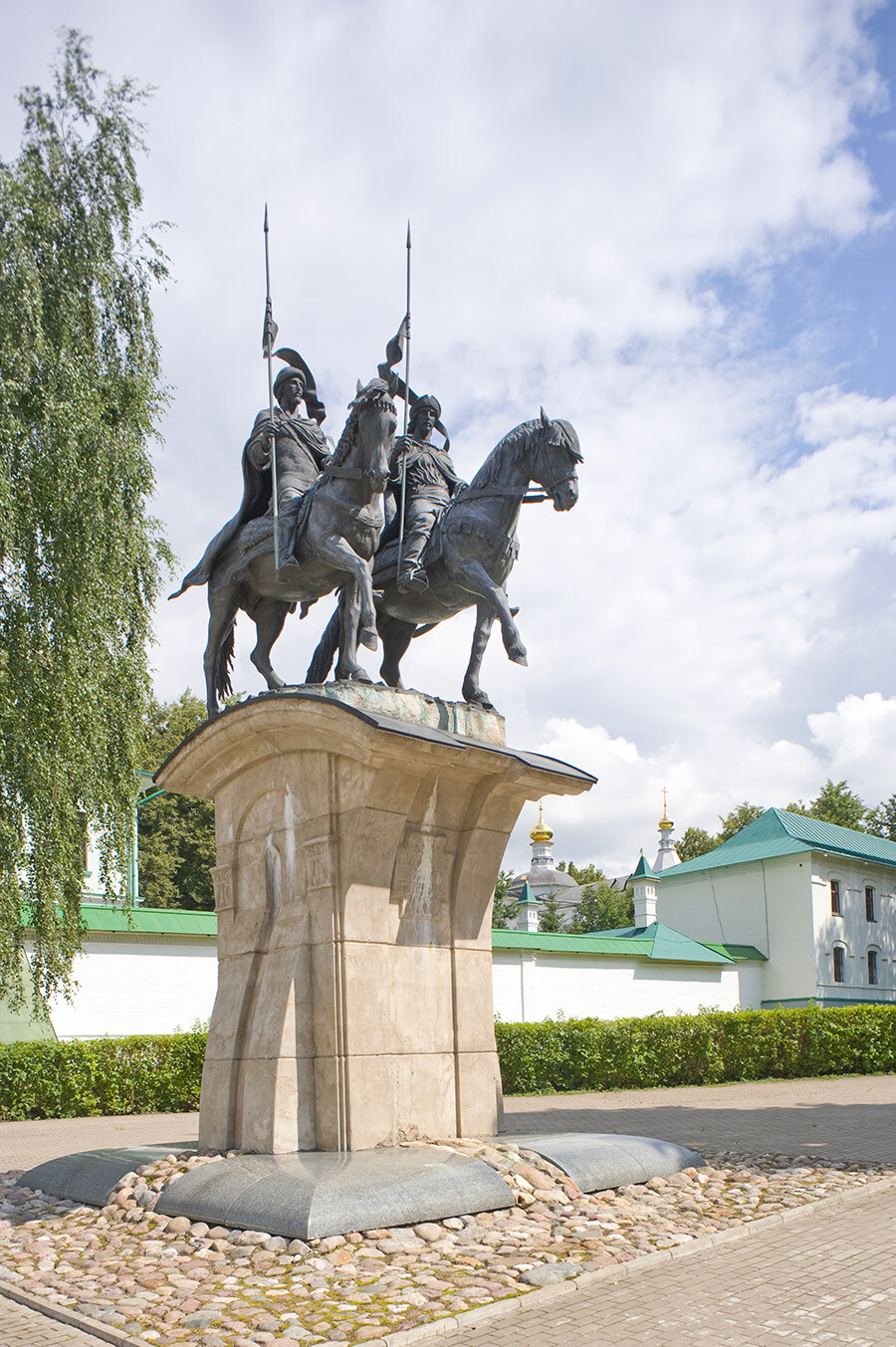
Monument to Sts. Boris & Gleb. Background: Monastery of Sts. Boris & Gleb, west wall. July 18, 2015
William BrumfieldUnfortunately, the town’s favorable economic situation in the 16th century came to an abrupt end during the chaotic latter part of Ivan the Terrible’s reign. The prince of Dmitrov at this time was Vladimir Andreevich (Staritsky), grandson of Ivan the Great and cousin of Ivan the Terrible.

Monastery of Sts. Boris & Gleb, Cathedral of Sts. Boris & Gleb. South view with bell tower. July 18, 2015
William BrumfieldRelations between the two were complex and swung wildly between favor and suspicion on the part of Tsar Ivan. Accused by court intriguers of plotting to poison Ivan, Vladimir was himself forced to take poison in 1569. Many of his relatives were subsequently killed, yet Vladimir himself was buried with honor in the Kremlin’s Archangel Cathedral.
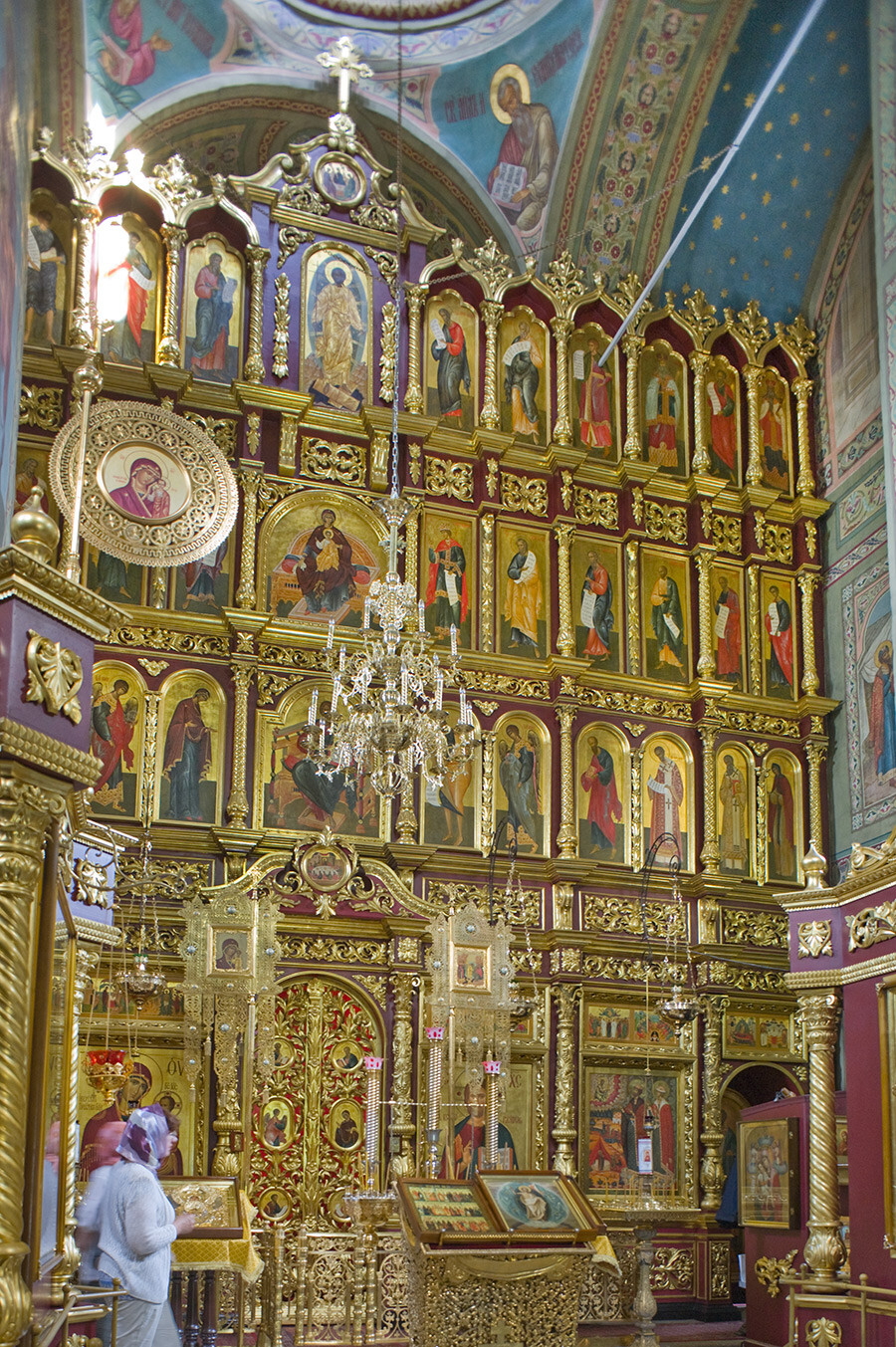
Monastery of Sts. Boris & Gleb, Cathedral of Sts. Boris & Gleb. Interior, view east toward icon screen. July 18, 2015
William BrumfieldWith the death of Prince Vladimir, Dmitrov was absorbed into Ivan’s personal realm, known as the oprichnina; but the greater problem for the town lay in the economic disruptions of during the social and political disorder of the late 16th century. After Ivan the Terrible’s death in 1584, Dmitrov’s position improved little during the reign of his son Fyodor, who died without heirs in 1598 as the last of the Rurikovich dynasty.
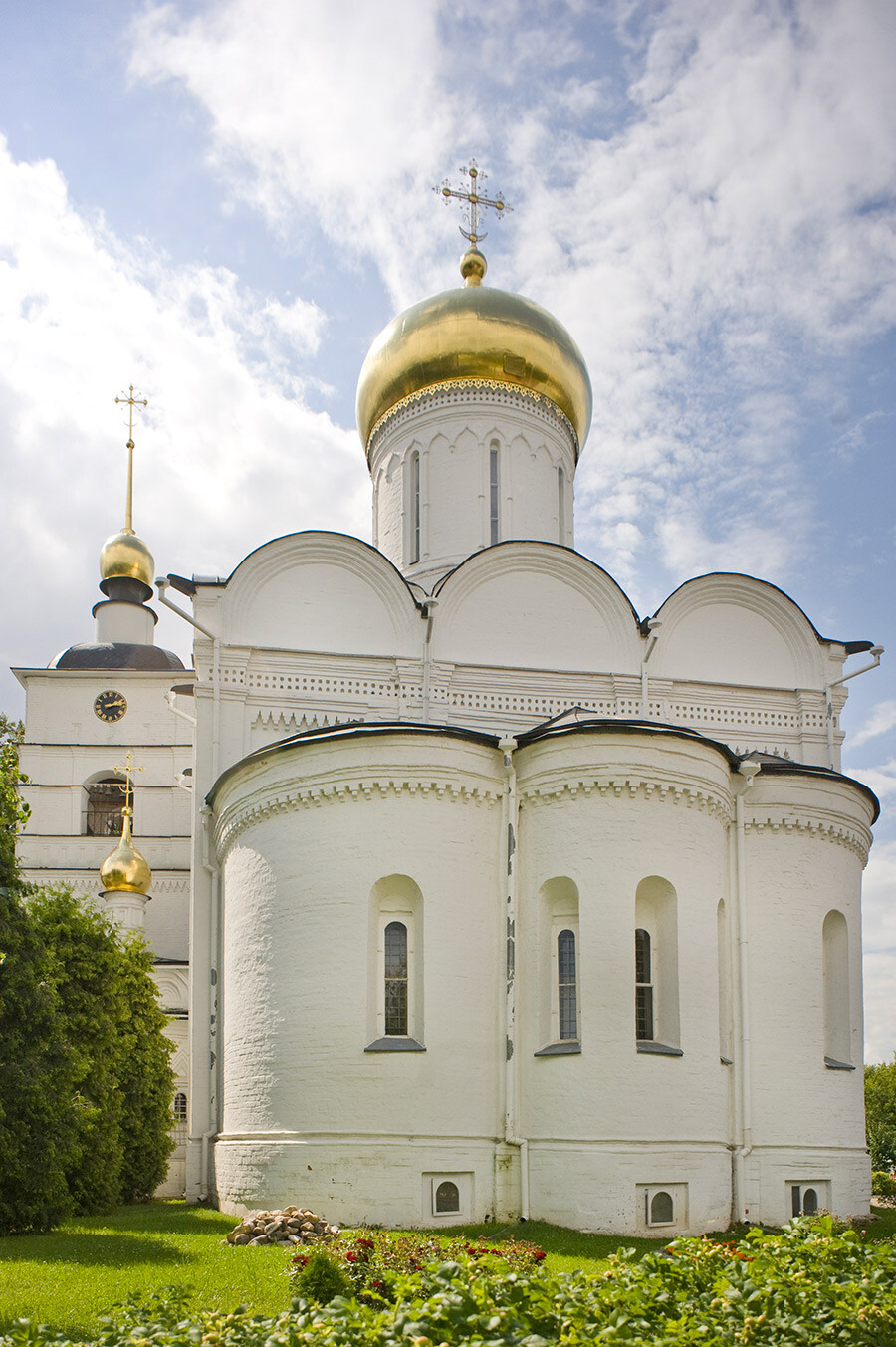
Monastery of Sts. Boris & Gleb, Cathedral of Sts. Boris & Gleb. East view. July 18, 2015
William BrumfieldFurther tribulations lay ahead for the town in the early 17th century, when Russia was plunged into a destructive interregnum known as the Time of Troubles following the death of Tsar Boris Godunov (1552-1605). Fighting among competing factions for the throne in Moscow led to widespread devastation, and Dmitrov was not spared.
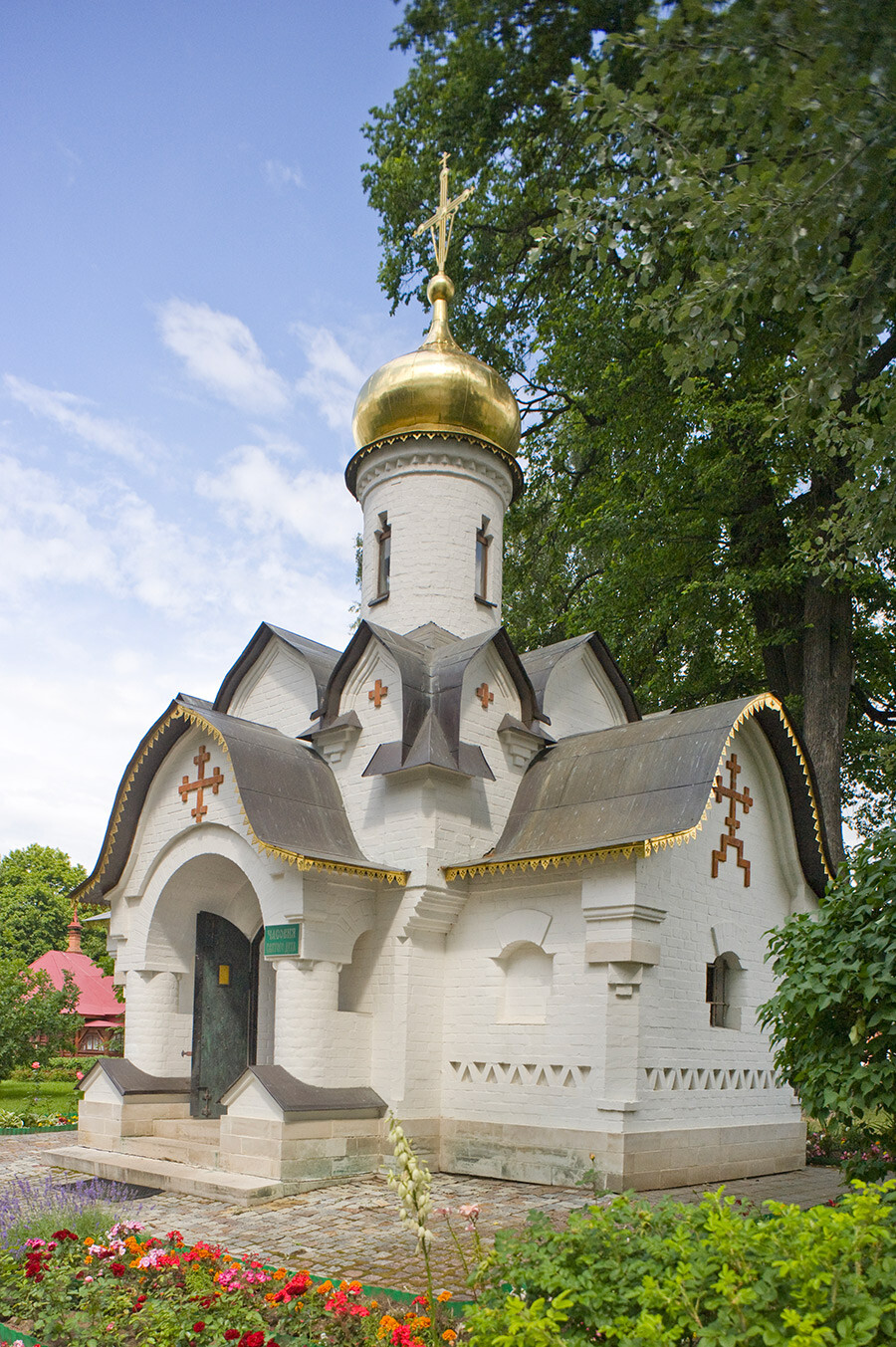
Monastery of Sts. Boris & Gleb, Chapel of Descent of the Holy Spirit. A fine example of Neo-Russian style, built 2004 as monument to 850 years of Dmitrov. Southwest view. July 18, 2015
William BrumfieldIn January 1610, Dmitrov was taken by Jan Piotr Sapieha (1569-1611), a leading commander of Polish-Lithuanian forces in support of various pretenders to power. Sapieha burned the wooden fortress above the great earthen ramparts, but he was compelled to abandon the town after a local defeat in February. Despite this small victory, years of destructive fighting lay ahead.
Following the establishment of the Romanov dynasty in 1613 and the return to a semblance of order by 1619, Dmitrov remained only a shadow of its former self. With gradual recovery during the 17th century, the town became a regional trading and administrative center.
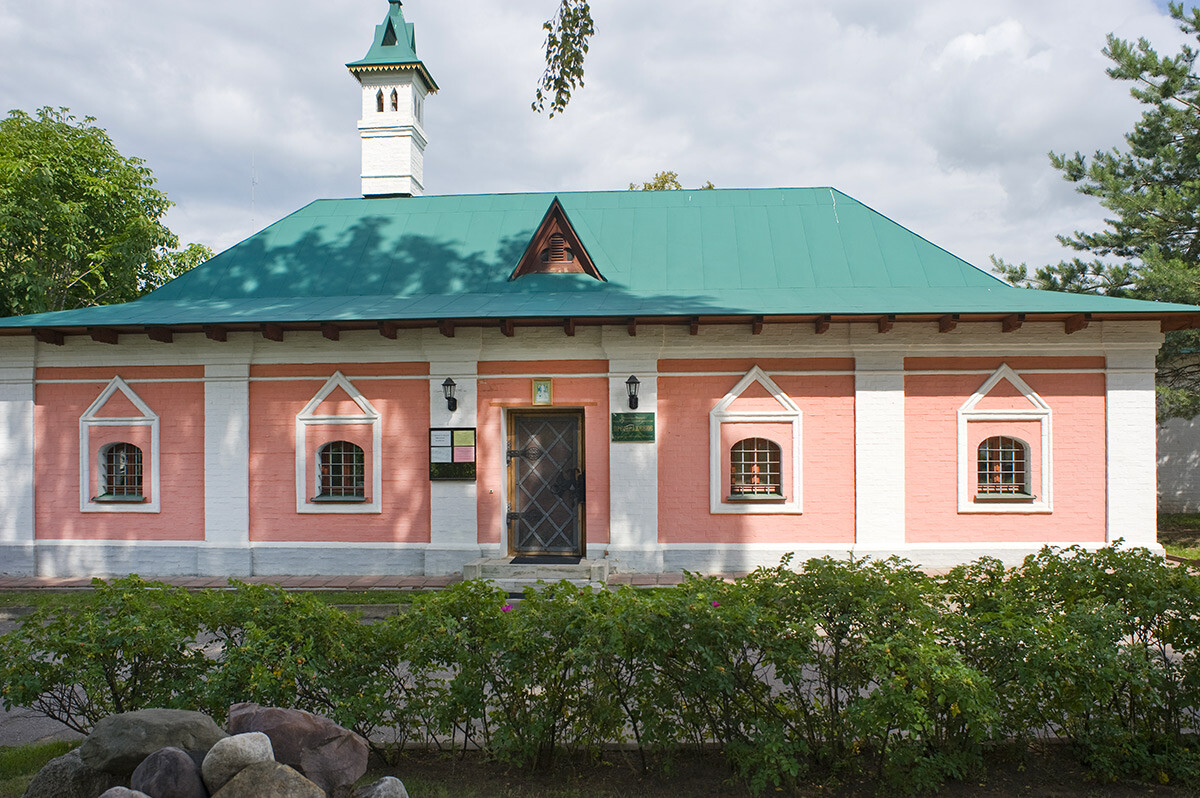
Monastery of Sts. Boris & Gleb, 17th-century administrative building. July 18, 2015
William BrumfieldDuring the 18th century, Dmitrov was graced with the construction of brick parish churches. Like many such towns, it gained a more regular plan in 1784 as the result of policies implemented during the reign of Catherine the Great.
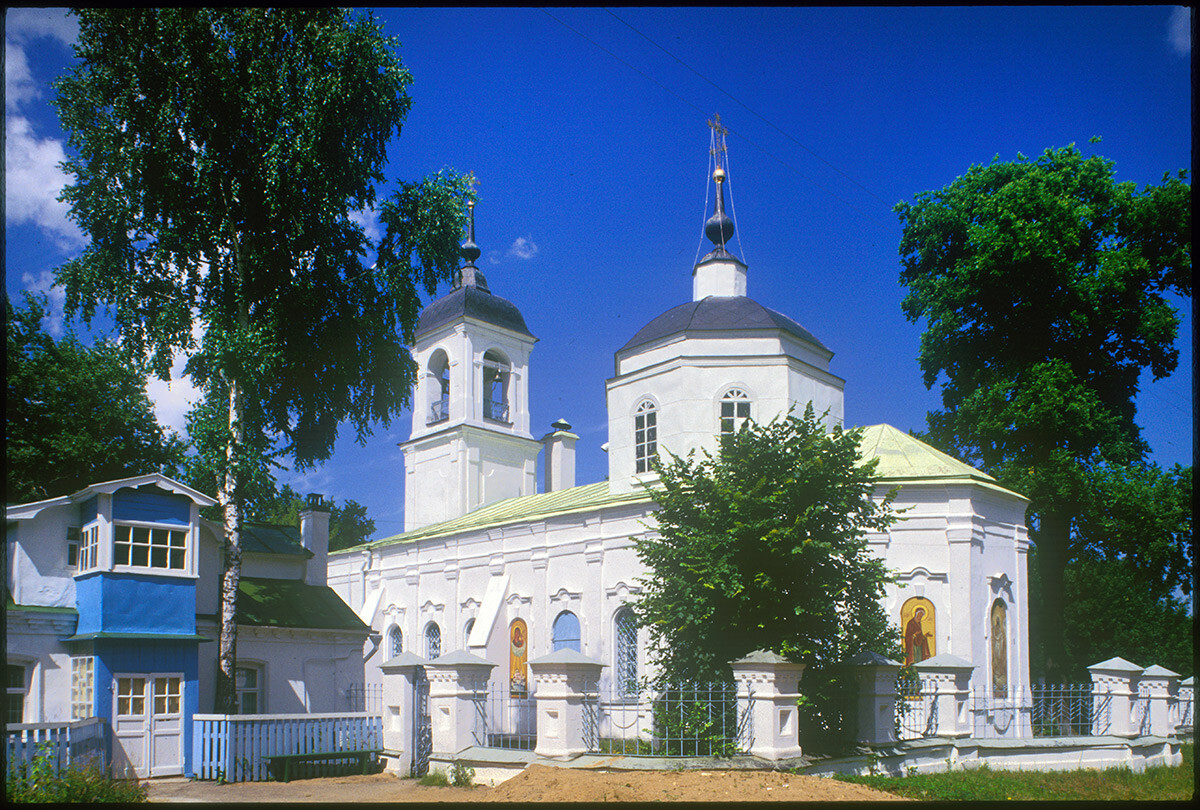
Church of Kazan Icon of the Virgin, southeast view. Built 1735 in provincial Baroque style (Rebuilt 1770s. Remained open throughout Soviet period). July 20, 1997
William BrumfieldDuring the Napoleonic invasion of 1812, the proximity of Dmitrov to Moscow placed it in the war zone. Field Marshal Mikhail Kutuzov delegated responsibility for covering the area north of the capital to Ferdinand von Wintzingerode, general of cavalry in the Russian army.
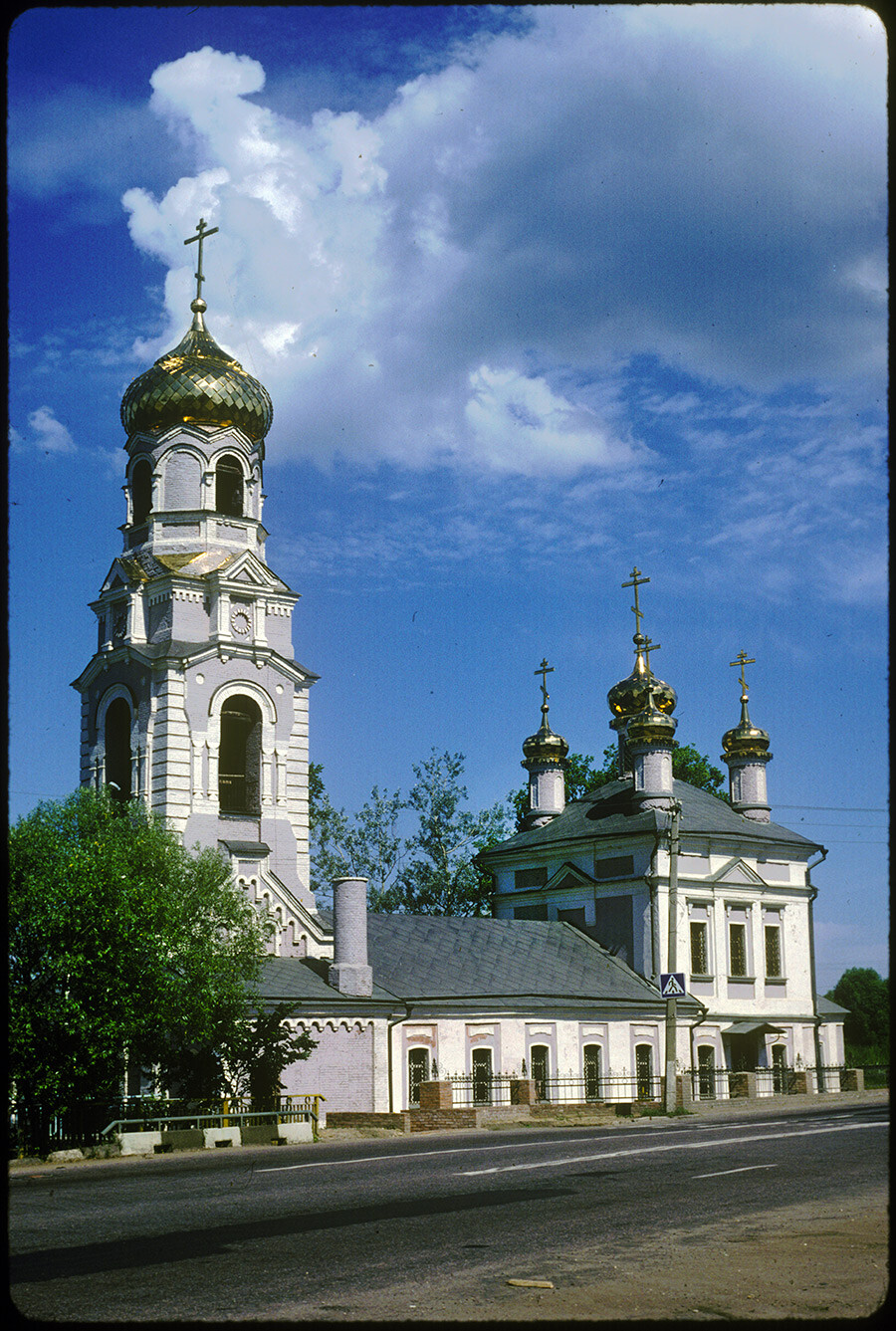
Church of the Purification, southwest view. Built 1814 in provincial Neoclassical style as monument to the 1812 victory; bell tower added 1883-4 by Sergey Rodionov. July 20, 1997
William BrumfieldOn September 29, a large detachment of French troops from the command of General Alexis Joseph Delzons occupied Dmitrov and proceeded to ransack the center (Delzons was killed less than a month later at the battle of Maloyaroslavets, a pivotal Russian victory in the French retreat from Moscow).
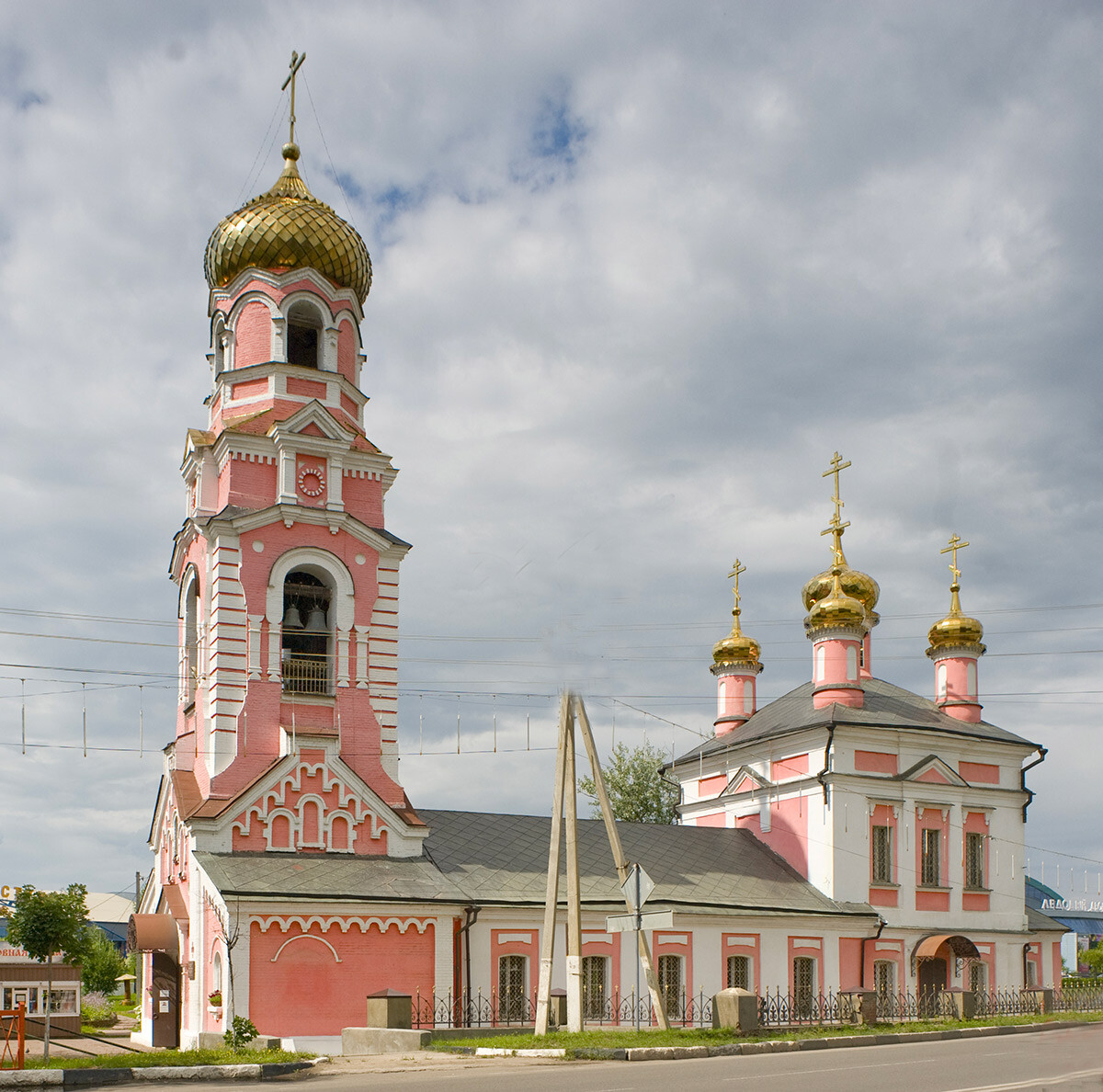
Church of the Purification, southwest view after restoration. July 18, 2015
William BrumfieldDmitrov was rescued by the movement of Wintzingerode’s troops from nearby Klin, and the French hastily withdrew on October 1. A wagon train with loot was recaptured by Russian forces. In gratitude, the town's merchants erected the Church of the Purification, completed in 1814 and now impressively restored.
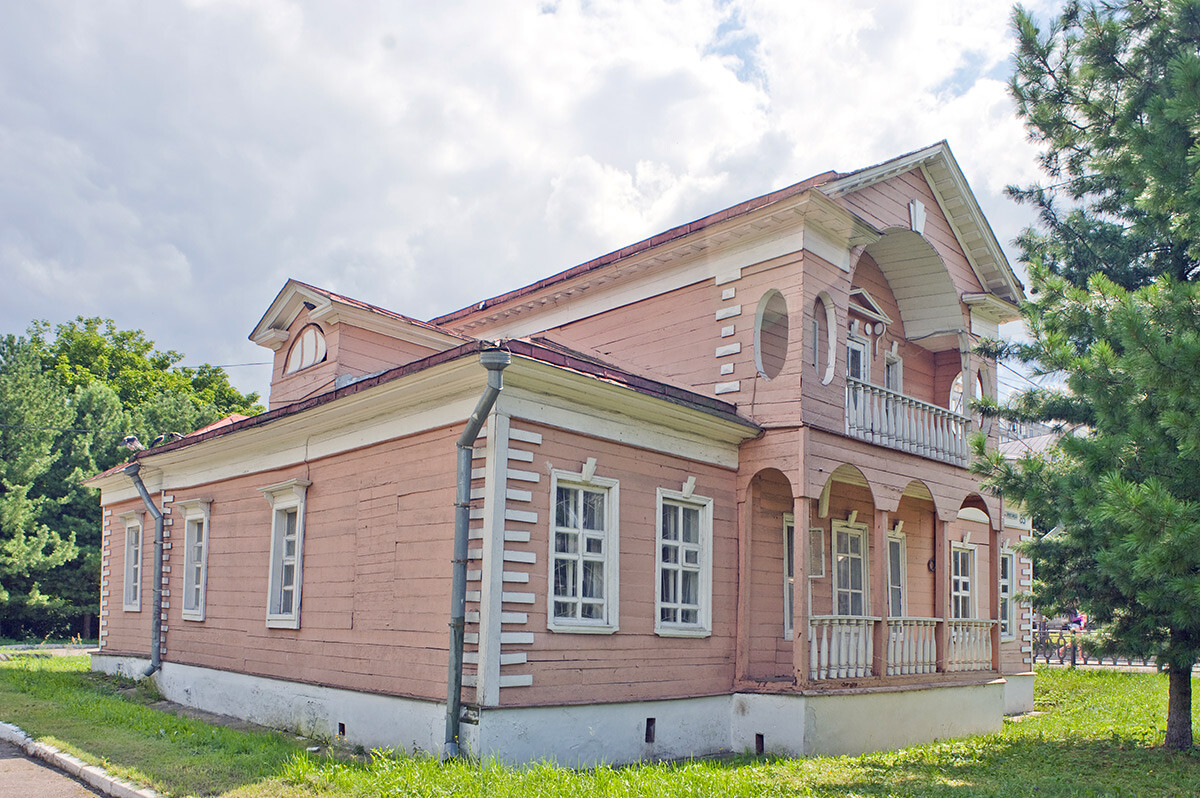
Kliatov house, Kropotkin Street 85. July 18, 2015
William BrumfieldAlthough much of the center of Dmitrov has been transformed by construction over the past century, interesting wooden houses remain from the 19th and early 20th centuries. Among them is the house of Mikhail Olsufyev, which served as a residence for the venerated social philosopher and anarchist Prince Pyotr Kropotkin (1842-1921) in the final years of his life.
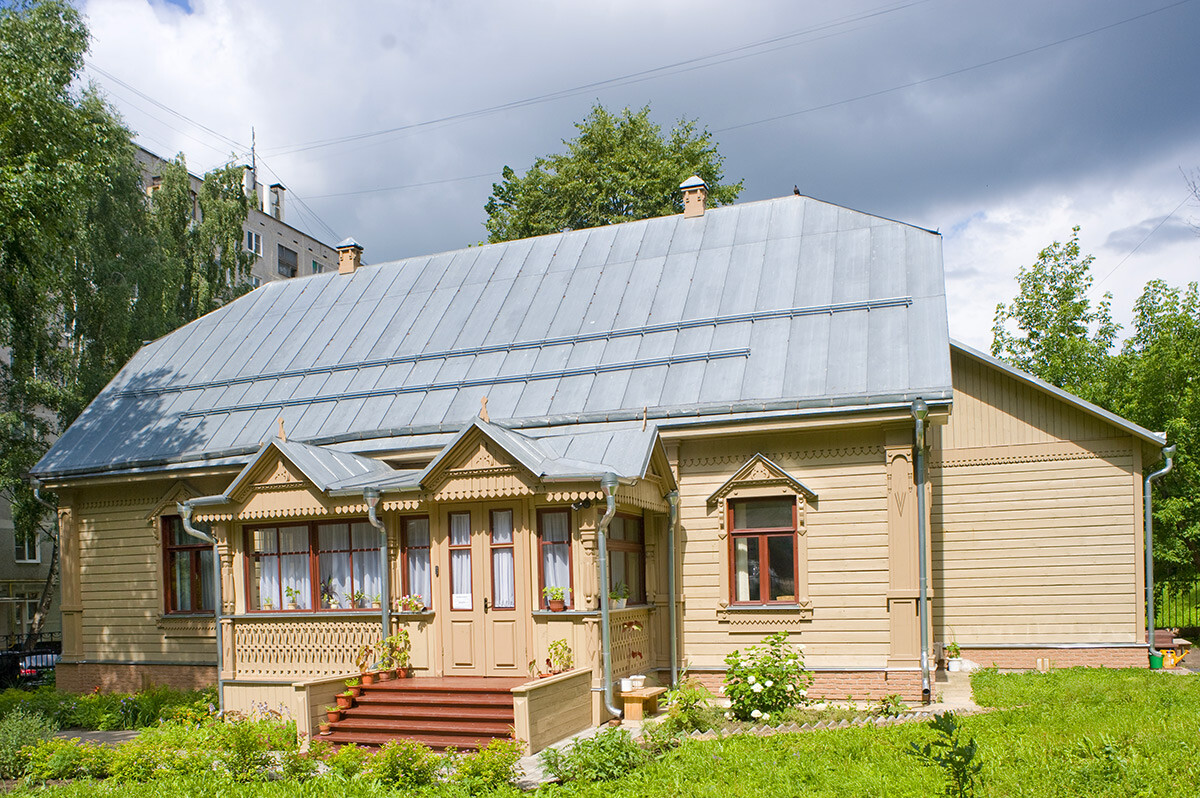
Mikhail Olsufyev house, Kropotkin Street 95. In their latter years, anarchist Peter Kropotkin & wife Sofya lived in this house, which is now the Kropotkin Museum. July 18, 2015
William BrumfieldWith the advent of Soviet power, Dmitrov maintained its position as a modest regional center in the shadow of Moscow. But in the early 1930s the town found itself at the center of one of the most important projects of the first Five-Year Plan. Faced with a looming water shortage for Moscow, the Central Committee in 1931 decreed the construction of a canal linking the Volga and Moscow Rivers to the north of the capital.
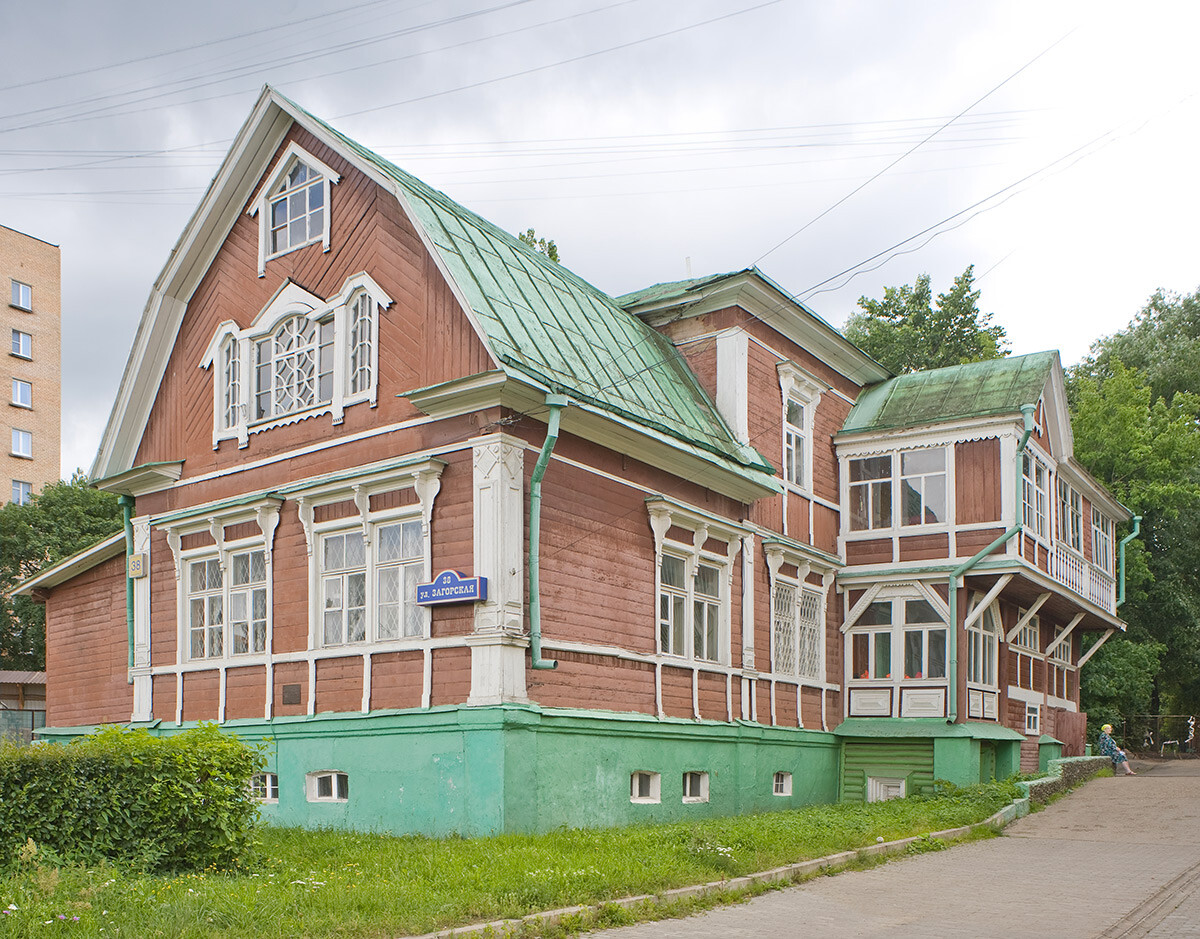
Olga Miliutina house, Zagorskaya Street 38. July 18, 2015
William BrumfieldIn 1932, the planned route of the canal included a segment of the Yakhroma River, which was to be channeled straight through the town of Dmitrov. Intending to reduce costs and with limited technology, the Soviet government turned to the massive use of concentration camp labor.
Overall responsibility for the project was given to Genrikh Yagoda (1891-1938), head of the NKVD (Soviet political police). During the five years of construction hundreds of thousands of Gulag laborers along the canal were supervised from the headquarters of Dmitrovlag, located at the former Monastery of Sts. Boris and Gleb.
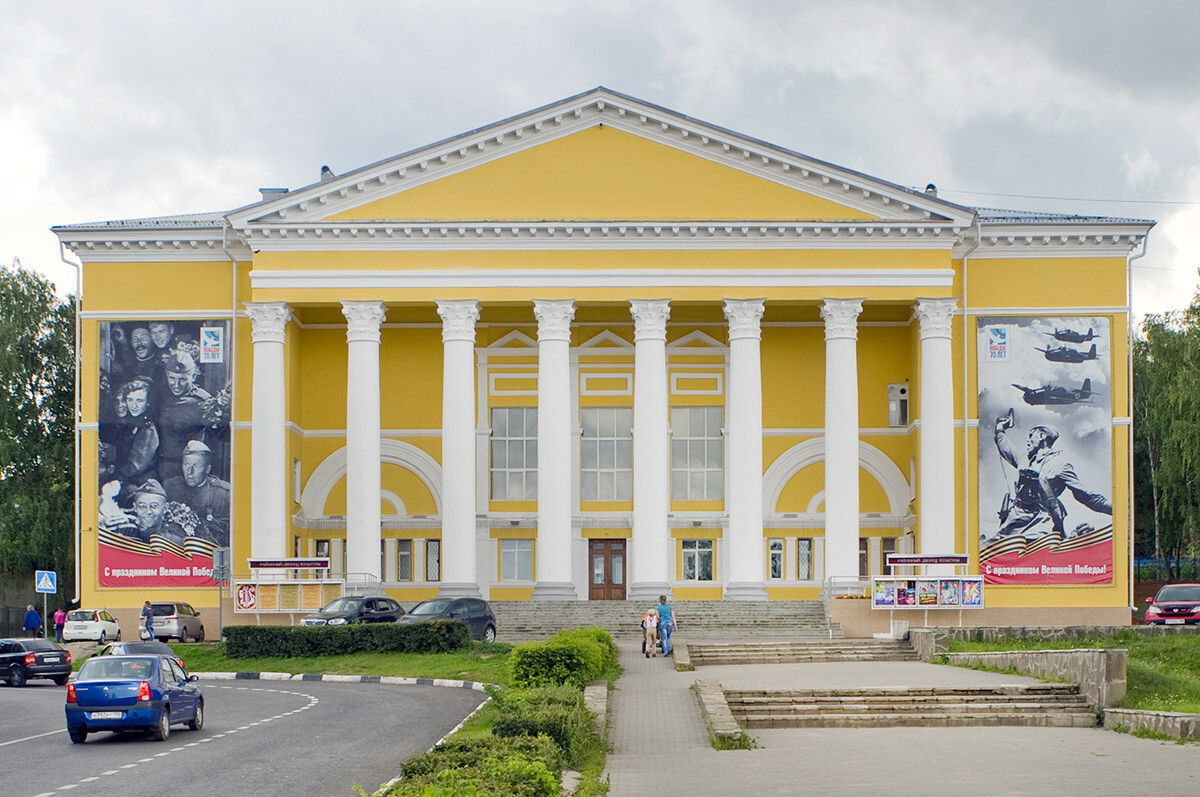
"Constellation" Regional House of Culture, Zagorskaya Street 64. July 18, 2015
William BrumfieldThe grim drama of the canal continued in the fall of 1941 during the Battle of Moscow Toward the end of November German forces attempted to cross the canal near Dmitrov as the northern part of a giant pincer movement to surround Moscow. By December 11, 1941 all of the Dmitrov region had been liberated, one of the critical initial steps in the first major victory over the Wehrmacht on the eastern front.
Today, Dmitrov is a prosperous regional center (population 64,000) benefiting from steady growth on the fringes of Moscow. Easily accessible by road and rail, the attractive, hospitable town has preserved a range of cultural monuments — above all its citadel and cathedral — that have major significance for Russian history.
In the early 20th century, Russian photographer Sergey Prokudin-Gorsky developed a complex process for color photography. Between 1903 and 1916, he traveled through the Russian Empire and took over 2,000 photographs with the process, which involved three exposures on a glass plate. In August 1918, he left Russia and ultimately resettled in France where he was reunited with a large part of his collection of glass negatives, as well as 13 albums of contact prints. After his death in Paris in 1944, his heirs sold the collection to the Library of Congress. In the early 21st century, the Library digitized the Prokudin-Gorsky Collection and made it freely available to the global public. A few Russian websites now have versions of the collection. In 1986, the architectural historian and photographer William Brumfield organized the first exhibit of Prokudin-Gorsky photographs at the Library of Congress. Over a period of work in Russia beginning in 1970, Brumfield has photographed most of the sites visited by Prokudin-Gorsky. This series of articles juxtaposes Prokudin-Gorsky’s views of architectural monuments with photographs taken by Brumfield decades later.
If using any of Russia Beyond's content, partly or in full, always provide an active hyperlink to the original material.
Subscribe
to our newsletter!
Get the week's best stories straight to your inbox